Summer Reading
(Tuesday June 4, 2002) June, July and August have always been a time for me to catch up on reading that I've neglected the rest of the year. For many of us, summer also is a time to go swimming and relax by the pool with a book in hand. Why not brush up on your favorite subject?
Bear in mind, that flamenco is a very subjective art form--what art form isn't? There are a number of books out there that many will claim to be a definitive reference for flamenco which others might denounce as pure garbage.
Learn a bit about the different versions of history and theory of flamenco, and decide for yourself which is
valid information and that which is not:
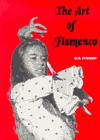 Art of Flamenco by Donn E. Pohren Includes an encyclopedic
section that has brief definitions of most of the more popular and also
the lesser known palos from alboreá to bulería to trillera to zapateado.
Hey, do you know the difference between Taranto and Tarantas?
Read this book and you'll know that and much more.
Art of Flamenco by Donn E. Pohren Includes an encyclopedic
section that has brief definitions of most of the more popular and also
the lesser known palos from alboreá to bulería to trillera to zapateado.
Hey, do you know the difference between Taranto and Tarantas?
Read this book and you'll know that and much more.
 Gypsy Cante: Deep Song of the Caves translated by Will Kirkland
Haven't read this one yet. On the cover is guitarist Diego del Gastor
with one of the Utrera sisters. Flamenco dancers and guitarists have
enough to keep themselves busy for a lifetime, but we all need to learn
about cante. Bonus points if you can name that cantaora: Bernarda or Fernanda?
Gypsy Cante: Deep Song of the Caves translated by Will Kirkland
Haven't read this one yet. On the cover is guitarist Diego del Gastor
with one of the Utrera sisters. Flamenco dancers and guitarists have
enough to keep themselves busy for a lifetime, but we all need to learn
about cante. Bonus points if you can name that cantaora: Bernarda or Fernanda?
 The Flamenco Dancer and the Biker by Michael Yatron Haven't read this
one either. It's a mystery book. What the heck, might as well escape
reality for a while with fiction related to flamenco. The Flamenco Dancer and the Biker by Michael Yatron Haven't read this
one either. It's a mystery book. What the heck, might as well escape
reality for a while with fiction related to flamenco.
 Peel My Love Like an Onion: A Novel by Ana Castillo Another fiction work. This one's also about a flamenco dancer. Read it just for fun.
Peel My Love Like an Onion: A Novel by Ana Castillo Another fiction work. This one's also about a flamenco dancer. Read it just for fun.
This are just a few ideas to get you started. Explore sites like Amazon and Flamenco Connection for yourself. Pick up a book and as you head for the pool, forget the sunblock!
Here's to a great summer!
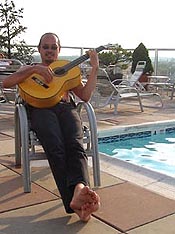 (Monday
June 3, 2002) I was in such
a good mood after spending an afternoon with friends at the rooftop pool
yesterday. We had food, drinks, music and good times. What more can one
ask for? (Monday
June 3, 2002) I was in such
a good mood after spending an afternoon with friends at the rooftop pool
yesterday. We had food, drinks, music and good times. What more can one
ask for?
Well, we made some new friends, got invited to another party. One person that we met was a former flamenco dance student who took notice when she heard the guitar and palmas por bulerías. Without even trying, my friends and I managed to promote DC flamenco while taking a "one-day vacation."
[Editor's note: I do not recommend taking a $5000
concert-quality flamenco guitar to a pool party where one big splash
of water upon such a fine and delicate musical instrument could cause some serious damage. For the above photo, I made
sure that there was no one swimming in the pool.]
Summer is coming soon! Here's what's on the calendar so far:
- May 31-June 16, 2002
Noche Flamenca at the New Victory Theater in New York.
- Saturday June 15, 2002 7:00pm
Natalia Monteleón's Arte Flamenco at the Gaithersburg City
Hall Concert Pavillion 31 South Summit Avenue, Gaithersurg, MD
- Saturday June 15, 2002 8:00pm
Carmen de Vicente's Requiebros Spanish Dance Group at the Gunston
Theater 2700 South Lang Street in Arlington, VA
- Wednesday and Thursday June 19-20, 2002 8:00pm
Noche Flamenca at Lisner Auditorium 730 21st St NW DC
- Friday June 21, 2002 8:00pm
Calle 54 at the Jim Rouse Theater in Columbia, MD
- Friday-Sunday June 21-23, 2002
Workshops with members of Noche Flamenca at the Oxford Academy
- Sunday June 23, 2002 7:30pm
Lizt Alfonso Dance Cuba at the Jim Rouse Theater in Columbia, MD
- Sundays June 30th & July 7th, 2002
Sevillanas Workshop with Anna Menendez at the American Dance Institute 1570 East Jefferson St in Rockville, MD
- Monday July 15, 2002 2:30pm
Flamenco Amazement (Lecture Demonstration for Children) at the Beltsville Library
- Sundays July 21st & 28th, 2002
Castanet Workshop with Anna Menendez at the American Dance Institute 1570 East Jefferson St in Rockville, MD
- August/Sept 2002
La Tati's workshop Exact dates and details coming soon!
See the calendar for more info about the above events.
Playing for different "species" of teachers
(Tuesday May 28, 2002) During the past eleven years that I've been involved in the flamenco scene, I've accompanied just about every dance teacher in the area (both in classes and performances).
So what I have learned? Lots of stuff--more than I can cover in one
article. Today, I'll illustrate how to play for several generalized types of dance
class teachers.
- Teach explainsitallus: Best for beginning accompanists. Why? This type of teacher
tells you exactly what music she wants you to play and provides palmas.
All you have to do is show up with your guitar and follow the dance
teacher. Pay attention, however: you still have to know when to stop
the music--usually she will say "last time" when the last compás is
coming. Still, it's your responsibility as an accompanist to sense when the routine has come to an end.
TIP: When the teacher explains the dance routine to the students, don't tune her out. Pay attention and listen and memorize the sequence.
- Teach youpickthemusicus: This is more challenging and therefore
geared towards more experienced accompanists. This type of teacher
will never tell you what to play nor will she tell you when to start.
Sometimes, the teacher might be working on a technique or rhythm pattern
where the guitar accompaniment functions only to beat out the time.
After a few repetitions of the dance routine, you should be able to
figure out what the rhythm is (12's as opposed to 8's etc). If you're
absolutely positive what the rhythm is, start playing at full volume.
Sometimes, you'll get the rhythm right, but you might be playing the
wrong variation (e.g. marking vs escobilla). If you're not sure, play
what you think the rhythm is at a low volume and see how the teacher
reacts and change the music accordingly.
TIP: as the teacher demonstrates the routine, listen to the melody
that she is humming and also listen to how the melody relates to the palmas--these are good clues to what
the rhythm could be.
- Teach mixofbothtypesus: This is probably the most common
type of teacher.
[Editor's note: what's with these strange made-up words above? Those of you who still remember your lessons from biology class can recall what they're all about: they're my humorous attempt to create my own scientific names for flamenco. Isn't my website very educationl? :) ]
Here are a couple of general tips to remember when working with any type of dance teacher:
- Remember that this is a class for the dance student.
While the class should be thankful to have live music, you also should
earn that thanks by being able to play the basic rhythms well enough
to keep the class going and not slow it down with your mistakes. It's
OK to make mistakes, but you have to recover from them AND keep the
compás. The dance student is paying her hard-earned money to learn
something in this class, not to listen to the teacher tell you how
to play.
- Remain quiet when the teacher is giving verbal explanations. Too many times, I've seen beginning accompanists practice falsetas or rasgueados at full volume while the teacher is trying to explain complex techniques or rhythms. This is usually distracting to the student. Rest your hands and pay attention to what the teacher has to say: learn something about flamenco dance!
- Situate yourself so that you don't block a student's view of
the mirror. Unless the teacher asks you to sit in a specific area of the dance studio, do the students a favor and don't block their view of the mirror. Also, place your guitar case and other personal belongings in an area that doesn't get in a dance student's space.
- Arrive to the class early. Arriving late can be disruptive
to the class. Arriving early will give you time to setup your amplifier
(if necessary), tune up and find a good spot to sit and possibly talk to the teacher beforehand. Some teachers will have a class routine where they prefer no music
in the first half and will therefore ask you to come later during
the class session.
- Learn the pecularities of the teacher's style. The teacher is the focus but you and the teacher are working as a team. Adapt to their individual styles. For example, teachers vary in the way they give you the count-off. For soleá some might go: "Seven..eight...nine...ten...eleven...twelve" while others will count a whole compás and some will just say "Ready...AND!" and some, especially Spaniards, will just say "¡Y!"
- You are indirectly giving the dance students musical ear-training. When the students practice the steps outside of class, they will be hearing in their head the music you played in that class. Give the dance students the best quality accompaniment you can give them. If you are working with another, hopefully more experienced, accompanist see my tips below in the article "It's OK to make mistakes."
- Concentrate!
Yeah, it can be mind-numbing to play the same things over and over
again. Believe me, you are building a new skill here: concentration! But there
will come a day when you will be asked to play for some of these dance
students in a performance. There will be footwork sections that will
seem to go on forever, and you can easily get mesmerized to the point where your mind will wander and you will lose track of the compás. Use this opportunity in dance class to work on your concentration.
I can go on and on, but again, these are enough tips to get you started. Good luck!
It's OK to make mistakes...
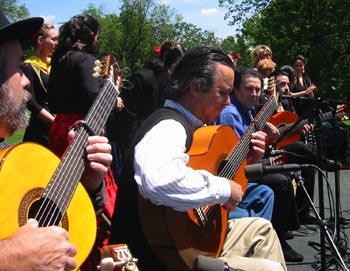 (Monday
May 20, 2002) Yesterday,
at Centro Español de Washington's Feria de Sevilla, yours truly had the
pleasure of performing with many of my fellow guitarists (see photo).
At one point in the afternoon, there were five of them onstage playing
together at the same time! Pictured here are guitarists Michael Blalock, Henry Jova, Jesús Serrano (behind Henry), singer Cuquito and guitarist Richard Marlow. At the bottom of the photo is the headstock of the guitar of yours truly. (Monday
May 20, 2002) Yesterday,
at Centro Español de Washington's Feria de Sevilla, yours truly had the
pleasure of performing with many of my fellow guitarists (see photo).
At one point in the afternoon, there were five of them onstage playing
together at the same time! Pictured here are guitarists Michael Blalock, Henry Jova, Jesús Serrano (behind Henry), singer Cuquito and guitarist Richard Marlow. At the bottom of the photo is the headstock of the guitar of yours truly.
It was a bit of a challenge but this wasn't a formal concert where one might strive for perfection. Of course, we all want to do our best, but the emphasis yesterday was to enjoy ourselves.
So how do five guitarists work together with no rehearsal? Here are a few tips:
- Figure out which guitarist is "in charge." Usually this is the most
experienced guitarist or the one who most frequently works with the
dancers and singers that are onstage. When things musically go wrong,
you should be able to quickly glance at the head guitarist and figure
out what you should be doing.
- Tune your guitar. If possible, quickly double-check your tuning with the guitarists next to you.
- Listen carefully to the singer and keep your eyes and ears on the dancer (see photo below). Try to blend-in dynamics-wise and musically mesh with the guitarists next to you. If you're not sure what you're doing, keep playing but slightly back away from the microphone, play softer and quickly glance at the head guitarist and figure
out what you should be doing
- Make sure your cejilla (capo) is at the correct fret and that you know what key you're supposed to be playing in.
- Sometimes, the head guitarist might play some complicated falsetas (e.g. silencio in alegrías) that he/she has worked out with the dancer and singer ahead of time. If you're not sure what to play, it's better to fade out your playing, let the head guitarist have some room to musically breathe. When the complicated falseta is finished, you can fade back in.
- Don't forget about dynamics (loudness and softness). Unless you have monitor speakers, there's a tendency for guitarists to play excessively loud. Five guitarists playing excessively loud sounds like mush. Not good. Listen to the head guitarist's dynamics. If he's seated too far for you to hear him/her, watch his strumming hand to get an idea of what level of dynamics you should be playing.
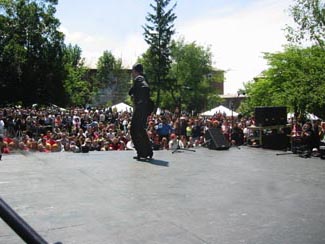 I
could go on and on, but this should be enough to get you started.
We all make mistakes--even us more experienced guitarists. We're just
better at covering up those mistakes, getting back in compás and moving
on. I
could go on and on, but this should be enough to get you started.
We all make mistakes--even us more experienced guitarists. We're just
better at covering up those mistakes, getting back in compás and moving
on.
Playing with other flamenco guitarists in a performance is a challenge
if you really want to create a beautiful inspiring musical backdrop
for the singers and dancers, but it takes a serious effort to make it
work. When everyone is "clicking" together, it can be a very satisfying
experience. I highly recommend it!
The DC Feria is THIS Sunday!
(Tuesday May 14, 2002) It's
the biggest local flamenco event for the DC community. The DC Feria is on Sunday May 19th from 12:30pm to 6:00pm at Fort Reno Park near the Tenleytown metro {see map). Admission is FREE! While many people may go to enjoy the free performances by several of the local flamenco groups, I just want to alert you to other things worth checking out:
 1. SPANISH FOOD! There will be several kiosks representing
several regions of Spain with their most well-known dishes. The portions
are usually small and you'll have to purchase tickets to get some food,
but it's for a good cause. The DC Feria is organized by the Centro Español
de Washington. 1. SPANISH FOOD! There will be several kiosks representing
several regions of Spain with their most well-known dishes. The portions
are usually small and you'll have to purchase tickets to get some food,
but it's for a good cause. The DC Feria is organized by the Centro Español
de Washington.
TIP: get to the Feria early and do a quick reconaissance of the kiosks
to see what dishes are being prepared. Locate the kiosks that will be
serving what you want and as soon as the food is ready, get in line
quickly!
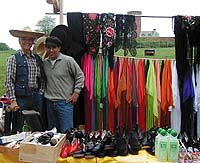 2.
SHOPPING! Usually there are several vendors selling flamenco and
Spanish-related products. TIP: bring sufficient cash because there are no ATM's nearby. Practice your bargaining skills. 2.
SHOPPING! Usually there are several vendors selling flamenco and
Spanish-related products. TIP: bring sufficient cash because there are no ATM's nearby. Practice your bargaining skills.
3. PARTIES!
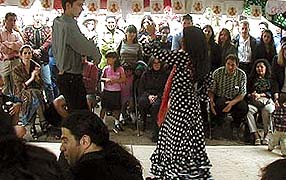 So what to do flamencos do for fun when they're not performing? Between
shows, head to the casetas (tents) and see for yourself. There
will be a dance floor and live music (or a boombox). TIP: don't be afraid
to get up on the dance floor and join in.
So what to do flamencos do for fun when they're not performing? Between
shows, head to the casetas (tents) and see for yourself. There
will be a dance floor and live music (or a boombox). TIP: don't be afraid
to get up on the dance floor and join in.
 Additional tips: Additional tips:
- It's forecasted that we will have showers the day before--the ground
may be muddy--so wear shoes that you can throw out. (Soheila la Persa)
- Fort Reno Park is in a residential area so parking will be a pain
in the butt. Allow extra time or better yet, take the metro.
- CULTURAL AWARENESS Anytime you have the urge to go and experience
a new cultural event, it is important that you keep one thing in mind:
try to step outside of the box and learn new things.
Obviously this is your goal if you are attending a cultural event,
but there seems to be a trend which I most certainly would recommend
against. DON'T JUST WATCH! Gather the most you can from everything
you do and don't be afraid to ask questions. Some things, and I
say this from personal experience, are quite confusing in foreign
cultures. The Flamenco community, like many other heritage-rich
communities, is most commonly very welcoming and willing to guide
the new learner in their discovery.
So, take it from me, the questions can only add to your experience...it's okay to be curious! (Anonymous Anthropologist)
- If you have another tip to add, just email
me
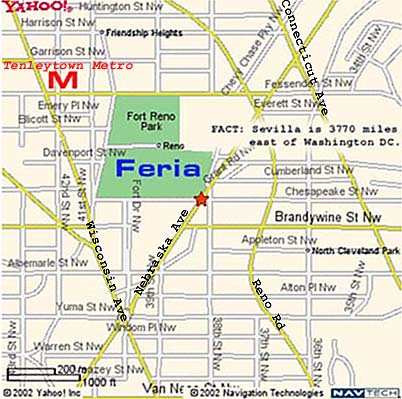
On Saturday May 18th (the day before the DC Feria), there are two events worth checking out too:
- Arte Flamenco will perform at the Kennedy Center's Millenium Stage
at 6:00pm sharp. This will feature the Arte Flamenco company,
local guest artists as well as special guest singer Cuquito.
TIP: get there at least an hour early to ensure you will get the best available seats--admission is FREE and seating is first-come first-served. There is a free shuttle at the Foggy Bottom metro which leaves for the Kennedy Center every 15 minutes or so. The show ends at 7:00pm sharp which gives you plenty of time to head to the next event...
- Pre-Feria party at the Taberna del Alabardero restaurant at 8:00pm
sharp. Taberna is located at 1776 I St NW DC near the Farragut
West metro.
It's not mandatory that you wear formal attire, but this
is a fancy (and expensive) place, so please dress appropriately. TIP: you absolutely must bring
cash, preferably ones, fives and tens. If a lot of people come, paying
the tab at the end of the evening will be a serious headache when
everyone has $20 bills.
Be careful what you wish for...
(Thursday
May 2, 2002) I like my job as a flamenco guitarist, if you can call it a job. It's a good life: getting paid to do what you love, introducing people to flamenco. The downside is that I can't easily take time off to go to concerts on the same nights as my tablao shows.
An ideal situation for me would be to have a number of competent available flamenco guitarists that I can call when I want to take time off. And I know there are a number of DC area flamenco guitar students who are dying to get started playing for dancers. Keep working at it! Someday soon I hope to be able to depend on you!
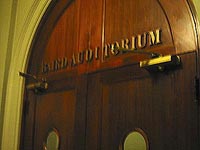 Anyway, last night there was a lecture performance at the Smithsonian's
Baird Auditorium that I so much wanted to attend. But the best I could
do was sneak in during the tech rehearsal. Here are the photos.
Enjoy!
Anyway, last night there was a lecture performance at the Smithsonian's
Baird Auditorium that I so much wanted to attend. But the best I could
do was sneak in during the tech rehearsal. Here are the photos.
Enjoy!
Just because you can, doesn't mean you should...
(Wednesday
April 17, 2002) I'll admit
that, without hesitation, I've burned copies of flamenco CD's for my friends.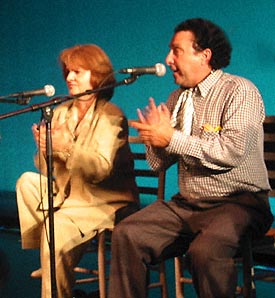
But last Saturday, guest flamenco singer El Cuquito asked me
to sell his tapes at the intermission of the Arte Flamenco concert.
I sold ten tapes and gave Cuquito the cash. It wasn't much, but he was
still pleased to have made some extra money for the night. Actually
seeing the money go from the purchaser to the artist made me realize
that sales of these tapes is really a part of his living.
Pictured on the right is El Cuquito with Salvadora Galan.
Just because I can easily copy CD's (or tapes) for my friends, doesn't
mean I should. Sure, making free copies for one's friends does
help increase the popularity of an artist, but every copy means one
less paying customer for the artist.
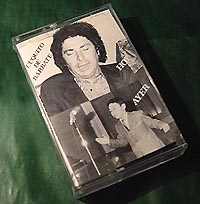 In Cuquito's case, I could've
just bought one tape and made multiple copies for my friends. But that
wouldn't be fair. In Cuquito's case, I could've
just bought one tape and made multiple copies for my friends. But that
wouldn't be fair.
It's something to think about the next time you make a copy of a CD (or tape) for your friends.
[Editor's note: Cuquito will be performing tonight April 17th at Toro Tapas at Shirlington Village (south Arlington, VA). Call (703)379-0502. Support this artist by buying one of his tapes.]
Read this brief article about mechanical rights. Post your comments about this topic on the message board.
The cante comes first!
(Tuesday April 9, 2002) "The dancer comes first," I explained to a guitarist friend of mine. "All those cool falsetas you learned don't mean squat if it doesn't somehow complement the dance."
"No, first comes cante, then the dancer and finally the guitarist," interjected one of the dancers.
"I know that, but here in DC where most of the shows have no cante,
it's a different mindset," I replied, "you have to deal with the fact
that there is no singer and learn to get inspiration from the guitarist's
music instead."
When I perform, I don't pretend to replace the singer but I still pour my heart into my music whenever I play for a dancer, so I get put off when dancers dismiss my music by saying things like, "That's really beautiful Miguelito, but I really need the cante to be inspired."
Years ago, New York-based singer La
Conja came to one of my shows here in DC and afterwards asked me,
"How do you do it without the cante?"
I didn't know what to say. I just took it for granted that flamenco can be done without cante since I've been doing it for years. But every now and then when we do have a singer, I realize what she's talking about. I really can't put it into words. You have to experience it for yourself.
And, it just so happens that this Saturday April 13th, Arte Flamenco's
Spring Concert will feature two very special guest flamenco singers from Spain:
- Salvadora Velasco, from Utrera, Spain. Salvadora has performed
in the U.S. with Romería Flamenca
- Cuquito de Barbate, from Barbate, Spain, (via Madrid). Some
of you may have seen Cuquito before, as he has performed a number
of times at the Taberna del Alaberdero.
Arte Flamenco Spring Concert details
WHEN: Saturday April 13, 2002 at 8:00pm
WHERE: the Clarice Smith Center's state of the art Kay Theatre. Directions
TICKETS: (301)405-ARTS
|
You owe it to yourself to experience flamenco with cante, the way it was really meant to be experienced. Attendance is mandatory! I will be taking attendance! :)
Many thanks to La Tati, Joaquín of Amor de Dios in Madrid, and Edwin
Aparicio for engaging singers for us on short notice.
Also to be featured in this concert are local guitarists Jesús Serrano, Henry Jova and Richard Marlow; local dancers Anna Menendez, Edwin Aparicio and Sara Jerez and the Arte Flamenco Dance Company directed by Natalia Monteleón.
Cuquito will be in DC for six weeks; he will also be peforming at the Smithsonian on May 1st, with Arte Flamenco at the Kennedy Center on May 18th, and with Arte Flamenco on May 19th. Details in the calendar.
Unfortunately, the originally scheduled singers Silverio Heredia and Keka were not able to make it to the U.S.
due to illness and last minute doctor's instructions. We wish them speedy recovery.
[earlier articles][later articles][main index]
|

 I
could go on and on, but this should be enough to get you started.
We all make mistakes--even us more experienced guitarists. We're just
better at covering up those mistakes, getting back in compás and moving
on.
I
could go on and on, but this should be enough to get you started.
We all make mistakes--even us more experienced guitarists. We're just
better at covering up those mistakes, getting back in compás and moving
on.






 1. SPANISH FOOD! There will be several kiosks representing
several regions of Spain with their most well-known dishes. The portions
are usually small and you'll have to purchase tickets to get some food,
but it's for a good cause. The DC Feria is organized by the Centro Español
de Washington.
1. SPANISH FOOD! There will be several kiosks representing
several regions of Spain with their most well-known dishes. The portions
are usually small and you'll have to purchase tickets to get some food,
but it's for a good cause. The DC Feria is organized by the Centro Español
de Washington.
 2.
SHOPPING! Usually there are several vendors selling flamenco and
Spanish-related products. TIP: bring sufficient cash because there are no ATM's nearby. Practice your bargaining skills.
2.
SHOPPING! Usually there are several vendors selling flamenco and
Spanish-related products. TIP: bring sufficient cash because there are no ATM's nearby. Practice your bargaining skills. So what to do flamencos do for fun when they're not performing? Between
shows, head to the casetas (tents) and see for yourself. There
will be a dance floor and live music (or a boombox). TIP: don't be afraid
to get up on the dance floor and join in.
So what to do flamencos do for fun when they're not performing? Between
shows, head to the casetas (tents) and see for yourself. There
will be a dance floor and live music (or a boombox). TIP: don't be afraid
to get up on the dance floor and join in. Additional tips:
Additional tips:



 In Cuquito's case, I could've
just bought one tape and made multiple copies for my friends. But that
wouldn't be fair.
In Cuquito's case, I could've
just bought one tape and made multiple copies for my friends. But that
wouldn't be fair.